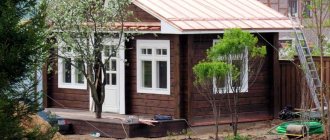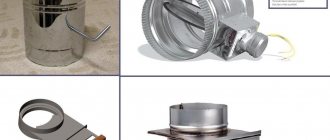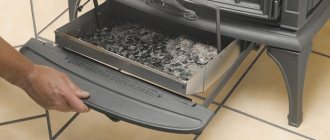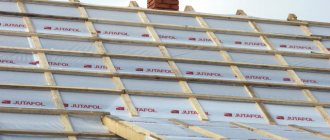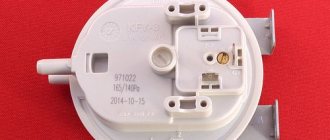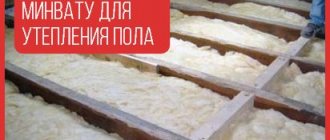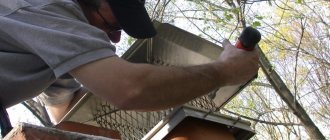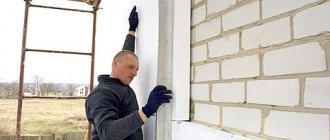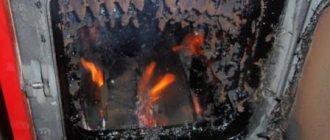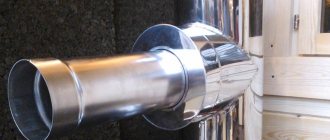During operation of the heating system, the appearance of moisture in the chimney harms not only the chimney itself, but also the heating device. By reacting with combustion products, moisture turns into chemically aggressive substances that disrupt the operation of the heating system.
It is impossible to completely get rid of condensation, but you can minimize its amount and prevent undesirable consequences.
Reasons for the formation of moisture in the chimney
When burned, any fuel for a boiler, stove or fireplace releases water vapor, which cools in the chimney pipe and forms a deposit in the form of droplets on the walls. This happens due to the temperature difference at the outlet of the heating unit and in individual parts of the chimney.
Additionally, moisture can enter the smoke channel from the outside during rain. The chemical reaction of water with soot and resins leads to the formation of acids and alkalis.
Condensate flows down along the smooth walls, where it accumulates, preventing the removal of smoke and impairing draft. Rough surfaces retain and absorb moisture, subject to corrosion and premature destruction.
In addition, substances accumulated in the chimney can enter the room, causing an unpleasant odor and harming health.
Note! Condensation can form not only from the inside, but also from the outside of the chimney - at very different temperatures in the pipe and outside. The result may be destruction of the pipe itself, if it is made of moisture-absorbing materials, as well as the walls and roof at the points of contact with the chimney.
What can you do to reduce the formation of condensation?
1. Heat the stove with well-dried wood
. To do this, they need to be split and kept under a canopy for 1.5-2 years.
2. Eliminate air leaks
through the valve and other leaks.
On my stove, I sealed the gap between the frame and the valve with sealant on the advice of Alexander Kutuzov.
If the suction occurs through leaks in the brickwork, then you need to cover the seams with mortar or plaster
3.Insulate the chimney.
Water will not condense on a warm chimney. I observed this with two neighbors living across the street from each other. They have similar fireplaces and the height of the chimneys is approximately the same. One of them has a chimney passing through a warm residential attic, and has no problems with condensation.
4. Ensure that the temperature of the flue gases in the chimney is not lower than 100 degrees.
Cold smoke comes out of the chimney when a small amount of wood is burned in a massive stove. The brick takes a lot of heat from the flue gases, and they come out of the chimney cold. For example, in 5 or 7 channel ovens. To increase the temperature of the exhaust gases, a direct channel of small cross-section is made from the furnace to the last channel. Such a channel is called a burnout, bypass or “ram”.
A lot of heat can be absorbed from the flue gases by the boiler built into the stove. I saw such a boiler built into a 5-channel stove. The water in the heating system heated very well, and the furnace array hardly heated up.
The temperature of the gases escaping into the pipe is also low in furnaces operating in smoldering mode. This happens when the blower door is tightly closed. There is not enough oxygen for normal combustion and the temperature in the firebox is low. In addition to condensate, a lot of soot is formed in the chimneys of stoves with this operating mode. I will talk about soot in another article.
Well, now a question from a regular reader of my blog, Anatoly:
I suggest discussing this topic on your blog, maybe someone will provide new solutions. The question is how to assemble a sandwich chimney? It seems to be correct for condensate, so that condensate does not flow into the gap between the inner and outer pipes. That's exactly what I did. The umbrella is also made for rain - the inner pipe is inserted into the pipe located below, the outer part is put on the outer shell of the sandwich located below. On the one hand, this is correct. Rain will not flow between the sandwich pipes and condensate, and the rain that has flown into the pipe will flow onto the valve. But! Condensation began to leak from under the outer shell of my umbrella. The smoke, when moving in the chimney, enters under the section of the pipe located above, rises to the top and, having reached the top, forms condensate, which drains from under the outer shell of the umbrella. This is bad. How to fix? In the photo, arrows show the places where condensation emerges; the photo was taken immediately after installation, so the place where condensation appeared is not visible and had to be marked with arrows.
Heating in a private house is carried out using stoves of various types, each of which requires the construction of a chimney. The main problems with smoke ducts are pipe clogging and condensation. If the chimney is clogged, cleaning is required, but condensation formation is more difficult to deal with. Condensation in the chimney pipe can lead to its premature destruction.
Factors influencing condensation formation
The process of condensation formation in the chimney channel depends on several factors:
- The moisture content of the fuel used by the heating system. Even apparently dry firewood contains moisture, which turns into steam when burned. Peat, coal and other combustible materials have a certain percentage of moisture. Natural gas, when burned in a gas boiler, also releases a large amount of water vapor. There is no absolutely dry fuel, but poorly dried or damp material increases the condensation process.
- Traction level. The better the draft, the faster the steam is released and the less moisture settles on the walls of the pipe. It simply does not have time to mix with other combustion products. If the draft is poor, a vicious circle results: condensation accumulates in the chimney, causing clogging and further impairing the circulation of gases.
- The temperature of the air in the pipe and the gases leaving the heating device. The first time after kindling, smoke moves through the unheated channel, which also has a low temperature. It is at the start that the greatest condensation occurs. Therefore, systems that operate continuously, without regular shutdowns, are least susceptible to condensation.
- Temperature and humidity of the external environment. In the cold season, due to the difference in temperatures inside and outside the chimney, as well as increased air humidity, condensation forms more actively on the outer and end parts of the pipe.
- The material from which the chimney is made. Brick and asbestos cement prevent the flow of moisture droplets and absorb the resulting acids. Metal pipes can be susceptible to corrosion and rust. Chimneys made of ceramic blocks or stainless steel sections prevent chemically aggressive compounds from clinging to a smooth surface. The smoother the inner surface and the lower the moisture absorption capacity of the pipe material, the less condensate will form in it.
- Integrity of the chimney structure. If the tightness of the pipe is broken or damage appears on its inner surface, the draft deteriorates, the channel becomes clogged faster, and moisture from the outside can get inside. All this leads to increased steam condensation and deterioration of the chimney.
We recommend reading: How to ventilate plastic windows
Consequences of condensation inside the chimney
Water vapor from the exhaust gases, turning into water, settles on the cooled inner surface of the chimney. Drops of liquid, mixing with other combustion products, flow down the pipe, gradually rendering it unusable.
This destructive effect is due to the aggressiveness of the mixture of condensate and soot deposits. The acid formed on the inner walls over time corrodes the metal and other materials from which the pipe is made. It is worth noting that the problem of the appearance of acid condensate is inherent only in stove heating. When using gas equipment, liquid is formed only from water vapor.
The acid solution especially quickly destroys the brickwork of the upper section of the pipe, which is often subject to freezing and thawing during the cold season. Falling bricks and dark streaks of unpleasant odor are the consequences of irresponsible installation of a brick chimney in our climate.
Acidic condensate eats through chimneys made of ordinary steel. Moreover, attempts by some owners to protect them from the outside with anti-corrosion agents do not bring results, since destruction occurs from the inside. Stainless steel pipes will last much longer.
The accumulation of liquid in the pipe also leads to deterioration of draft, which will result in an unpleasant odor in the room.
Chimney design requirements
Compliance with the requirements of the rules and regulations during the construction and operation of the smoke exhaust system will extend its service life, including by minimizing the formation of condensate:
- When the pipe is positioned vertically, horizontal sections no more than a meter long or inclined sections, but without sharp corners, are allowed.
- The internal surface of the chimney must be smooth, without protrusions, cracks or other irregularities.
- It is not allowed to reduce the diameter of the channel compared to the outlet pipe of the heating unit.
- The ability to clean the chimney is an important requirement when constructing a chimney.
- To ensure good draft and free removal of combustion products, the height of the pipe must take into account the height of the roof of the heated building.
How to fix the problem?
Even if you fulfill all the requirements when constructing a chimney, condensation will not be completely avoided. In a finished design this is even more impossible. But the problem can be solved by getting rid of the condensate that has already formed, reducing its concentration and minimizing the destructive consequences:
- Use dry fuel only. During combustion, less moisture will be released, soot formation will be reduced, in addition, such fuel produces more heat at lower costs.
Important! This method will not help when using a gas boiler, since it is impossible to reduce the amount of water vapor released during the combustion of natural gas.
- If the chimney is made of hygroscopic material, lining is used. A stainless steel pipe is laid inside the shaft, which absorbs the effects of aggressive substances. The sleeve will solve another problem - it heats up faster than brick or asbestos cement, which means drops will not form at the very beginning of the chimney.
- Insulating parts of the pipe located outside the heated room will help reduce the temperature difference. The smoke will cool more slowly, most of it will have time to disappear along with the condensation steam. For this purpose, thin steel pipes are wrapped with heat-insulating materials or hidden in an additionally constructed brick shaft.
- To improve draft, you should clean the chimney and eliminate any damage to the integrity of the pipe. This will facilitate the removal of combustion products and protect the system.
- To prevent rain and debris from entering, the top of the chimney is equipped with a cone-shaped nozzle - a deflector. It does not let sediment inside and also improves traction.
- A condensate drain should be installed at the beginning of the chimney and at bends in the structure. Mount it in such a way that it is easy to empty when filling.
We recommend that you read: How to make your own pipe bender for bending copper pipes
Reasons for the appearance of condensation in the chimney pipe
The exhaust gases contain water and other liquids in the form of steam. When gases are cooled, the steam becomes supersaturated, water collects in droplets and tends downwards - this is the main reason for the appearance of condensation. In a flow of hot gases, this process occurs near the colder walls of the chimney - and it is there that drops of liquid settle, forming condensation.
When considering the reasons for the appearance of condensation, it should be borne in mind that there is no smoke without water vapor; the presence of liquid collecting on the walls of the chimney cannot be avoided.
Reasons for the increase in the amount of condensing liquid in chimneys:
- uninsulated chimney, especially from single-layer galvanized pipes;
- the pipe is too long - significant cooling of the smoke occurs in the upper part;
- low exhaust gas temperature. This is especially true for modern units with a heat exchanger for connecting the heating system. It is desirable that the temperature of the gases leaving the furnace head be at least 100 °C;
- a large difference between the temperature of the ambient air and the exiting smoke;
- raw fuel (especially firewood);
- narrowing of the hog's clearance due to soot deposits and, as a result, a decrease in traction;
- low combustion temperature with incomplete combustion of fuel due to insufficient supply of fresh air, which leads to low smoke temperature and low draft;
- design flaws of the chimney - the presence of horizontal and inclined sections (exceeding the permissible standards of 2000 mm horizontal projection); discrepancy between the cross-sectional area of the channel and the design area (it is bad to both reduce and increase the cross-section);
- the ingress of precipitation in the absence of a deflector or cap increases the amount of liquid in the chimney channel;
- Rough walls inhibit exhaust gases more and collect more condensate than smooth ones.
Preventive measures
Serious condensation problems can be avoided through preventive maintenance. A number of preventive measures that are taken in a timely manner will facilitate the maintenance of the heating system and extend the life of its safe and efficient operation:
- cleaning the chimney - the absence of blockages will ensure good draft and rapid removal of combustion products and water vapor (at least once a year);
- releasing the condensate drain from moisture as it fills;
- routine inspection and necessary repairs of the entire heating system.
All this work, if carried out regularly, will reduce the amount of condensate and avoid many other problems in the operation of the heating and smoke exhaust system.
Note! Prevention must be carried out before the start of the heating season, and it will not hurt after its completion.
Protection of the smoke channel from precipitation
This is done using caps specially designed for this purpose, which are equipped with the tops of chimneys.
Some head models have built-in deflectors inside: this allows the product not only to perform protective functions, but also to help increase traction. In the same way, you can reduce condensation in the chimney pipe of a gas boiler.
Preventive actions
To reduce the percentage of condensation inside the chimney, carry out the following actions:
- The brick chimney duct is equipped with a metal pipe (the so-called “sleeving”). This makes cleaning the channel from soot much easier. In addition, this seals and insulates it: in this case, condensation occurs in noticeably smaller quantities, and it is removed faster.
- Install a special device for collecting condensate. It is best to do this at the place where the vertical and horizontal parts of the channel intersect: this is where it is most convenient to remove moisture from the gas flow. During maintenance of the condensate collector, it will be necessary to remove accumulated water from it from time to time.
- Use well-dried high-quality fuel.
- Carry out regular cleaning activities. The best time for this is mid-autumn, ahead of the start of the heating season.
- If necessary, repair the chimney.
Even if all the above recommendations are strictly followed, this will not guarantee the complete absence of condensation in the chimney, since this phenomenon will in any case accompany the operation of the furnace equipment. However, significantly reducing the percentage of moisture loss is a completely feasible task: this will increase the efficiency of the system and extend its service life.
Source

